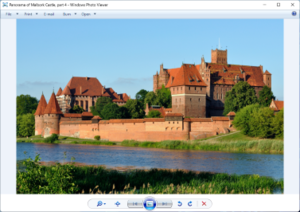Image viewing software
Windows Photo Viewer (formerly Windows Picture and Fax Viewer)[1] is an image viewer included with the Windows NT family of operating systems. It was first included with Windows XP and Windows Server 2003 under its former name. It succeeds Imaging for Windows. It was temporarily replaced with Windows Photo Gallery in Windows Vista[2] but was reinstated in Windows 7 with its current name.[3]
Windows Photo Viewer can show individual pictures, display all pictures in a folder as a slide show, reorient them in 90° increments, print them either directly or via an online print service, send them in e-mail or burn them to a disc.[3][4][5] Windows Photo Viewer supports images in BMP, JPEG, JPEG XR (formerly HD Photo), PNG, ICO, GIF and TIFF file formats.[6]
Windows Photo Viewer is deprecated in Windows 10 and later in favor of a Universal Windows Platform app called Photos. The program can no longer be accessed by normal means, however it can be brought back with a registry tweak.[7][8]
Features
Compared to Windows Picture and Fax Viewer, changes have been made to the graphical user interface in Windows Photo Viewer.[citation needed]
Whereas Windows Picture and Fax Viewer uses GDI+,[9] Windows Photo Viewer uses Windows Imaging Component (WIC)[10] and takes advantage of Windows Display Driver Model.[11]
Although GIF files are supported in Windows Photo Viewer, Windows Photo Viewer only displays the first frame of the animated GIF[12] whereas Windows Picture and Fax Viewer displays animated GIFs in full. Windows Picture and Fax Viewer was also capable of viewing multi-page TIFF files, (except those that employ JPEG compression)[13] as well as annotating the TIFF files.[14][15] Windows Photo Viewer, on the other hand, has added support for JPEG XR file format[6] and ICC profiles.[16][17]
Bugs
Some devices and Android phones are able to take photos and screenshots and have a custom ICC Profile being applied to said pictures, however Windows Photo Viewer will display an error when trying to display the picture with the message "Windows Photo Viewer can't display this picture because there might not be enough memory available on your computer." when an unknown ICC Profile is detected. There is a patch available on GitHub that fixes this behavior.[18]
Also, regarding ICC Profiles, when a custom Display ICC Profile is applied after installing a Monitor driver, Windows Photo Viewer wrongly shifts the picture hue to a warm tint. This feature is intentional but is greatly exaggerated. This can be fixed by removing or replacing the Display ICC Profile.[19]
In Windows 10 and later
In support documentation, Microsoft states that Windows Photo Viewer is not part of Windows 10, and a user still has it only if they upgraded from Windows 7 or 8.1.[20] However, it can be brought back in Windows 10 and later with registry editing, by adding the appropriate entries ("capabilities") in HKEY_LOCAL_MACHINE\SOFTWARE\Microsoft\Windows Photo Viewer\Capabilities\FileAssociations. It is also possible to restore the Preview option in the context menu.[7][8]
Windows Photo Viewer itself remains built-in into Windows and is still set by default for TIFF files with the extensions ".tif" and ".tiff".[7][8][21]
